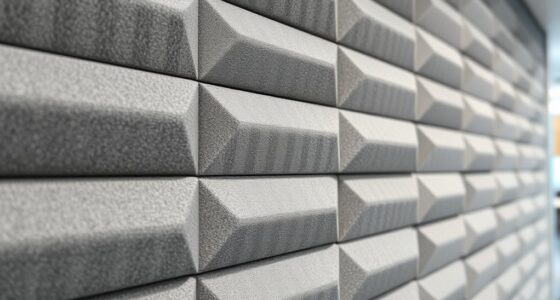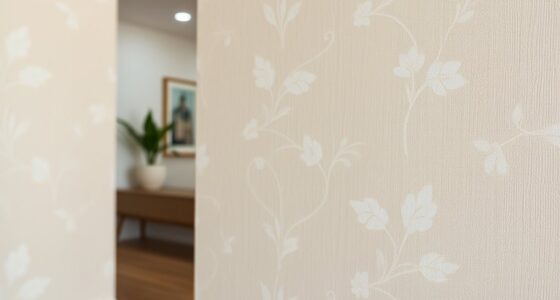Wallpapering sloped ceilings and dormers can be tricky, but proper planning makes it manageable. Start by choosing flexible, durable wallpaper suited for uneven surfaces, like vinyl, and guarantee your space is well-lit with bright, adjustable lighting to see seams and bubbles clearly. Measure carefully, cut pre-formed strips for complex angles, and prepare surfaces thoroughly. Good lighting and technique will help you achieve a seamless finish—continue exploring for expert tips to master the process.
Key Takeaways
- Use flexible, durable wallpaper like vinyl for uneven or angled surfaces such as dormers and slopes.
- Measure carefully and consider pre-cut strips for complex angles to simplify application.
- Ensure strong, primer-coated surfaces and clean walls for optimal adhesion on sloped areas.
- Work during well-lit conditions with adjustable, directed lighting to identify seams and bubbles early.
- Start wallpapering from the top or most visible point, smoothing as you go to ensure pattern alignment and a clean finish.

Wallpapering sloped ceilings and dormers can be challenging, but with the right tools and techniques, you can achieve a professional look. One of the most important considerations is how lighting options affect your wallpapering project. Natural light can reveal imperfections and make colors appear different than in artificial lighting, so plan your work during the day when the space is well-lit. If natural light is limited, guarantee you have sufficient artificial lighting—bright, adjustable fixtures that can be directed to highlight your progress and spot any issues. Proper lighting helps you see seams, overlaps, and bubbles clearly, reducing mistakes and guaranteeing a smooth finish. Using adequate lighting can also help you avoid overworking certain areas, preventing uneven application or damage to delicate wallpaper.
Good lighting is essential for flawless wallpapering on sloped ceilings and dormers.
Material selection is equally vital when tackling sloped surfaces. You’ll want to choose wallpaper that’s flexible and durable enough to conform to uneven or angled surfaces. Vinyl wallpapers are often a good choice because they are more forgiving during installation and easier to clean afterward. If you’re working with textured or heavily patterned wallpaper, make sure the pattern can align seamlessly on the slopes and dormers. Light-colored wallpapers can help make small or dimly lit spaces feel larger and more open, while darker shades can add coziness but may require more precise application to avoid visible flaws.
Before you start, measure your space carefully and select wallpaper that’s appropriate for the size and shape of your ceilings and dormers. Consider the material’s weight and adhesive compatibility—some wallpapers require special adhesives or prep work, especially on sloped surfaces where gravity can cause issues. For intricate areas like dormers, pre-cut strips can help you manage complex angles more accurately. When choosing your material, think about the environment as well—if there’s a lot of moisture or humidity, vinyl or other moisture-resistant options will serve you better.
Once you’ve picked your wallpaper and lighting setup, prepare your workspace thoroughly. Clean the surfaces to remove dust and oils that can interfere with adhesion. Use a quality primer if necessary, especially on uneven surfaces, to promote better bonding. When applying the wallpaper, start at the top or the most visible corner and work your way down or outward, smoothing as you go to avoid bubbles. Adjust your lighting as needed to see the seams clearly, and take your time aligning patterns and trimming edges for a professional finish. With careful planning of lighting options and diligent material selection, wallpapering sloped ceilings and dormers becomes a manageable, even rewarding task.
Frequently Asked Questions
Can Wallpaper Be Removed Easily From Sloped Ceilings?
Removing wallpaper from sloped ceilings can be tricky, but it’s doable. You should start with gentle removing wallpaper tips, like scoring the surface lightly and using warm water or wallpaper removal chemicals. Always test a small area first. Use a putty knife carefully to lift the edges, and work slowly to avoid damage. Patience is key; with the right tools and techniques, you’ll be able to remove wallpaper smoothly.
What Tools Are Best for Wallpapering Dormers?
Imagine yourself carefully lining up the pattern as you work on your dormer. The best tools you’ll need are a smoothing brush or wallpaper roller for adhesive application, ensuring a seamless finish. Use a sharp utility knife for trimming edges and a plumb line to keep your pattern matching precise. These tools help you navigate tricky angles and create a polished look that transforms your space effortlessly.
How to Prevent Wallpaper From Sagging on Steep Slopes?
To prevent wallpaper from sagging on steep slopes, focus on proper surface preparation and adhesive techniques. First, clean and smooth the surface to guarantee good adhesion. Use a high-quality, stretch-resistant wallpaper and apply a strong adhesive, spreading it evenly to avoid air pockets. Work in small sections and press firmly as you go. This approach minimizes sagging and ensures a smooth, lasting finish on those challenging slopes.
Are There Specific Wallpaper Types for High Humidity Areas?
Imagine stepping into a humid bathroom where moisture lingers in the air. You need moisture resistant wallpaper, which stands firm against humidity’s challenge, preventing peeling or mold. Look for humidity friendly options like vinyl or coated papers, designed to endure damp environments. These specially crafted wallpapers provide a durable, beautiful finish that stays pristine, no matter how steamy the space gets, giving you peace of mind and a stunning, lasting wall.
How Long Does Wallpapering a Sloped Ceiling Typically Take?
You can expect wallpapering a sloped ceiling to take around 4 to 8 hours, depending on its size and complexity. To stay on schedule, plan your preparation tips carefully—measure accurately, gather all materials beforehand, and work in good lighting. Allow extra time for tricky areas or drying. Proper planning helps guarantee a smoother process and a professional-looking finish, even on those challenging sloped surfaces.
Conclusion
Don’t let the unique angles of sloped ceilings and dormers intimidate you. With patience and the right techniques, you can achieve a smooth, professional-looking finish that transforms your space. Remember, the extra effort pays off in a stunning, personalized room. Even if it feels challenging at first, trust your skills and take it step by step—you’ll be surprised how rewarding it is to see your vision come to life. Keep going; your perfect wall is within reach.









